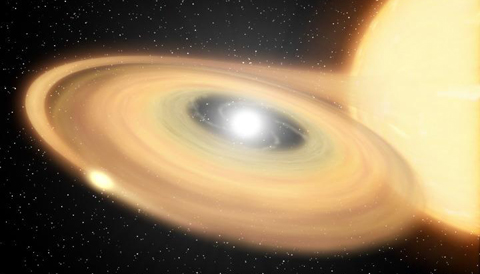In a classical nova, a white dwarf siphons material off a companion star, piling up material on its surface until thermonuclear processes kick off, creating a brilliant outburst. NASA / JPL-Caltech
Astronomers have detected gamma-ray emission from three classical novae, an unexpected discovery that has left them perplexed.
Some days, it seems like everything is dumped on you. As the pressure builds, you finally hit a point at which you just lose it and explode.
White dwarfs can have the same problem. When one of these stellar corpses funnels gas off a companion star, the white dwarf builds up a layer of material on its own surface until the temperature and pressure are so high that they trigger a thermonuclear explosion. The bright outburst, called a nova, can blaze for months. And unlike their brighter cousins the supernovae, novae don’t destroy the star and can actually repeat.
Observations with NASA’s Fermi Gamma-ray Space Telescope now show that nova-ing white dwarfs throw a surprisingly energetic fit when they’ve had enough. Fermi observations of three “classical” novae — V959 Monocerotis 2012, V1324 Scorpii 2012, and V339 Delphini 2013 — reveal that these eruptions produce gamma rays, heretofore unexpected from this type of system.
Each of the three novae emitted gamma rays over 2 to 3 weeks, with the gamma-ray peak following the optical peak by a couple of days. (The Fermi-LAT collaboration can’t confirm the delay for V959 Mon, because the nova was too close to the Sun for optical observations when detected with Fermi in June 2012.)
The gamma-ray delay happens because the material the white dwarf ejects initially blocks the high-energy photons from escaping, and the gamma rays can only get out when the material expands and thins.
Amateur astronomers actually helped confirm that two of the three transient gamma-ray signals came from novae. Amateurs fought the dawn to pick up the optical glow from V959 Mon in August, confirming the gamma-ray outburst was from a nova. After that, cooperation with spectroscopy-savvy amateurs enabled the Fermi collaboration to plan their observations of V339 Del after an amateur discovered that nova as well. The third nova was found by a professional team.
– See more at: http://www.skyandtelescope.com/astronomy-news/novae-surprise-with-gamma-rays-07312014/?et_mid=685005&rid=247466607#sthash.Dc8Yhu8h.dpuf

